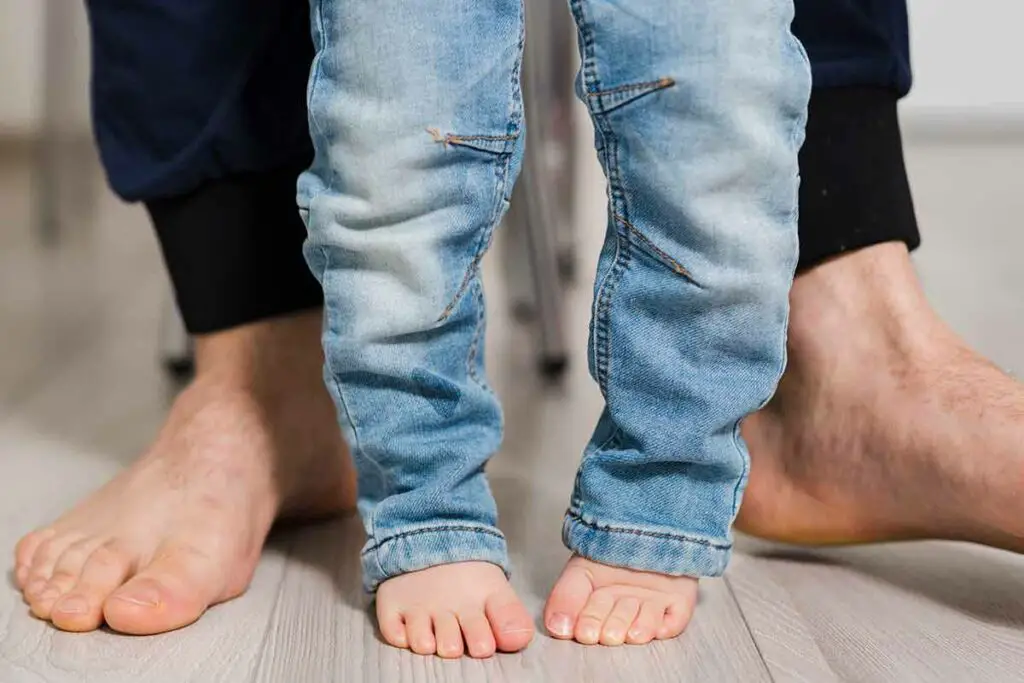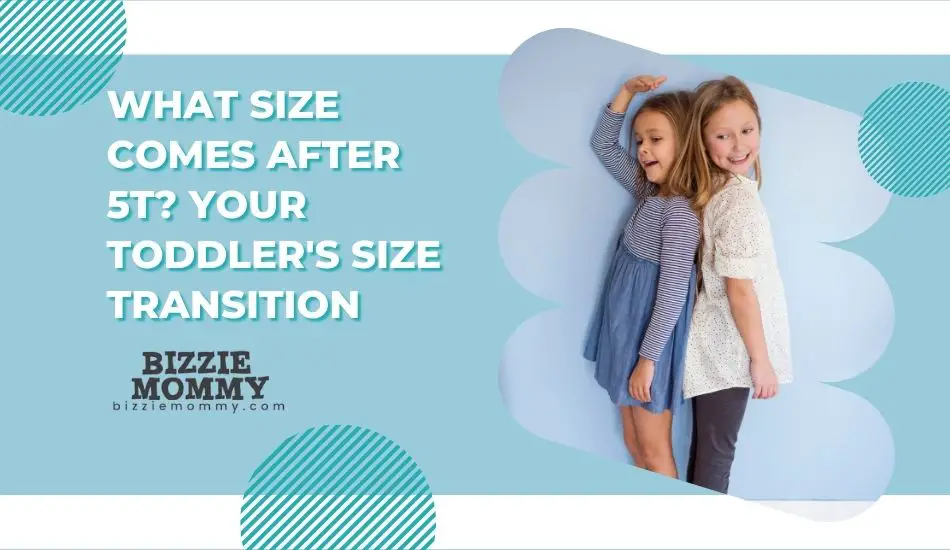When looking for toddler-sized clothing, many parents don’t know the right size to buy. Kids’ clothing sizes are not the same everywhere, and many clothing brands have different clothing sizes. So, what size should you buy, and how do you find the right size?
In the United States, the size of kids’ clothes is based on the age of the child. These sizes are generally used for children who are still learning to dress themselves. Some parents buy regular size 5 clothes once their child is potty-trained because it is possible that a size 6 might be too big, compared to a 5T. Ultimately, the choice of size depends on the kids’ and parent’s preferences.
How Are Toddlers’ Clothes Measured?
When measuring any baby clothes, there are a few things you must keep in mind: age, weight, and, most importantly, height. While age and weight will give you an overall idea about what to look for, height will determine the length of the clothes.
To take the child’s measurements, make them stand against a wall barefoot. Make sure their back, head, and heels are touching the wall. Using a measuring tape, mark the points on the wall at which dresses, pants, and other articles should fall. The brand and style also have a great influence on the clothing size. Most brands, even though they appear to be the same size, have certain alterations. That is why you should always check the toddler size chart to buy the right toddler clothes.
Remember that toddlers are in their growing stages of life and will grow out of clothes very quickly, so choose clothes that are slightly larger in size to provide for growth. This not only extends the life of the clothing but also allows for more relaxed freedom of movement. And hence, while determining a toddler’s clothing size might be difficult, with the correct information and technique, you can guarantee that you buy clothes that suit them perfectly. Carefully consider your toddler’s age, weight, and height, as well as the brand’s measurement chart, and always go for slightly larger sizes.
What is Size 5T?
Size 5T is the standard size for kids around age 5. The ‘T’ in 5T refers to toddlers, signifying that the size is created exclusively for kids who are in their early formative years.
The ‘T’ sizes differ from conventional sizes in that they are made with a larger form to fit the rounder tummies, bigger bottoms, and thinner waists of toddlers. Toddler sizes also often include comfier sleeves and shorter lengths to allow for more movement.
If talking about specific measurements, a size 5T often refers to a kid who has an average waist size of 21-22 inches, weight of 40-46 pounds, and who is 42-45 inches tall. However, you must remember that sizes might vary significantly between brands and designs.
It’s also worth noting that many clothing businesses don’t sell a size 5T and instead go directly from a size 5 to a size 6. Therefore, it’s important to consult the brand’s sizing guide to decide the ideal size for your child.
What is The Difference between Size 5 and 5T?
The fit and pattern of the clothes divide size 5 from size 5T. While size 5 is a normal size for children, size 5T is developed exclusively for toddlers in their early years of life. The following are some important differences between the two sizes.
Fit
Size 5 clothing is intended for children age 5 and above, while size 5T clothing is intended for larger toddlers. The ‘T’ in size 5T stands for ‘toddler,’ indicating that the size is intended to fit the specific measurements of a toddler, such as bigger bottoms, rounder tummies, and smaller waists. As a result, size 5T clothing has a larger shape, longer sleeves, and shorter lengths to facilitate more movement.
Specific measurements
Size 5 and 5T may both fit a kid who is 42-45 inches tall, although there are minor changes in the particular specifications. A size 5 has a waist measurement of roughly 22 inches, while a size 5T has a waist measurement of about 21 inches.
Availability
Another major difference between sizes 5 and 5T is the availability of these sizes. While size 5 is easily attainable from many clothing companies, size 5T is not as popular. Some manufacturers even skip the 5T size entirely and go straight from size 5 to size 6, while others only offer a small variety of apparel in size 5T.
It’s important to keep in mind that sizes might differ between brands and designs, so read the sizing chart of the brand to guarantee the ideal fit for your child.
What Size Comes After 5T?
When it comes to clothing sizes, 5T is often associated with clothes that fit a kid around age 5, with a weight measurement of 40-45 pounds. Clothing sizes after 5T, on the other hand, normally move to regular number sizes that match a child’s age and height.
For example, the next size up from 5T may be a size 6, which is intended to fit a 6-year-old whose height is between 46-48 inches. Sizes normally rise by one number for each year of age beyond size 6, such as size 7 for a 7-year-old, size 8 for an 8-year-old, and so on.
However, garment sizes can vary greatly between brands and manufacturers, so it’s always a good idea to check size charts and try on items before purchasing them to guarantee the best fit. Also, certain clothing manufacturers may continue to use the “T” sizing system after 5T; therefore, it’s imperative to read the precise sizing information offered for each item of clothing.
Exact Measurements of Size 6

In addition to using size charts, it’s important to keep in mind that children’s clothing sizes can vary significantly based on body type and other factors. For example, a child who is taller or shorter than average for their age may need to size up or down accordingly, while a child with a more slender or curvier body type may need to look for styles that are designed to accommodate their shape.
Ultimately, the best way to determine the right size for a child is to try on clothing to check the fit. Some brands may offer size guides or recommendations based on customer feedback or reviews, which can be helpful in making a decision. A size 6 in one brand, for example, may have a chest measurement of 24 inches, a waist measurement of 22 inches, and a hip measurement of 26 inches, but a size 6 in another brand may have somewhat different measurements. By taking the time to find the right size and fit, children can feel comfortable and confident in their clothing, which can help them enjoy their day-to-day activities to the fullest.
In addition to using size charts, remember that children’s clothing sizes can vary greatly depending on body shape as well as other variables. A kid who is taller or shorter than typical for their age, for example, may need to size up or down, while a child with a slimmer or chubbier body type may need to shop for designs that are made to fit their body.
What is The Difference Between 5T and 6?
Size and fit are the main factors differentiating a 5T from a 6. A size 5T is often used to describe clothing that fits a kid who is about 5 years old and weighs between 40 and 45 pounds, whereas a size 6 is meant to suit a child who is around 6 years old and stands between 46 and 48 inches tall.
Some of the key differences between 5T and 6 include:
Height
Height is the main difference between these sizes. A toddler who has grown taller and requires clothing that fits their long limbs and torso may be ready to go from 5T to size 6.
Weight
Although weight can be a consideration in size, it is really not that important when going from 5T to 6. At this age, children’s weights can vary dramatically; therefore, size 6 clothing is normally made to accommodate a variety of weights within a specific height range.
Style
One difference between 5T and 6 is the variety of clothing styles offered. 5T clothing is commonly made with smaller children in mind, with colorful designs and styles that parents will find cute and the child will find attractive. Size 6 clothes, on the other hand, may be more fitted and mature.
Sizing Systems
Size 6 belongs to a numeric sizing system for older kids, while 5T a belongs to the size system that is commonly used for younger children. Because size 6 is a more popular size, it may provide more choices of options and styles from which to pick.
While sizes 5T and 6 are both meant for young children, they reflect various phases of growth and development. As children age, the transition from 5T to 6 usually involves a change in size, style, and fit.
How Can You Measure a Child for Fitting Clothes?
Measuring a child for fitting clothes can ensure that the clothing fits well and feels comfortable. Here are some tips for measuring a child for fitting clothes:
- If you want to make sure your kid’s clothes fit just right, you might want to break out the measuring tape. It’s not the most exciting task in the world, but it can save you a headache later on. First, you want to measure your child’s height from their head to their feet. This is important if you want to make sure you’re getting the right length of pants or dresses.
- Next, let’s talk about chest measurement. You want to measure the fullest part of their chest, which is usually right under the armpits. This is useful if you’re trying to figure out what size tops or dresses to get.
- Then there’s the waist measurement, which you’ll want to take around the narrowest part of their waist, usually around the belly button. This can be really helpful for picking out pants or shorts that fit just right.
- Don’t forget about the hips! Measuring around the widest part of their hips can help you find the right size pants, shorts, or skirts.
- If you’re looking at pants or shorts, you’ll also want to measure the inseam. This is the length from the crotch to the ankle, and it’ll help you figure out the right length for your kid’s pants or shorts.
- Finally, you might want to measure shoulder width and arm length. Shoulder width is the distance between the shoulders from left to right, and it can help you pick out the right size jackets, coats, and tops. Arm length is the distance from the shoulder to the wrist, which is useful for long-sleeved tops and jackets.
Parents can pick clothes that fit very well and feel more comfortable for their kid by taking these measures and matching them to a size chart given by the company or shop. It’s also a good idea to try on clothes, if possible, because sizes often vary between brands and styles.
Bottom Line
Trying on clothes is the best way to figure out the size that fits your child. It can be frustrating when different brands have different sizing, but checking customer feedback and reviews is a great way to get a better idea of what toddler clothing sizes might work best. And let’s be real: there’s nothing worse than wearing clothes that are either too tight or too loose. Comfort is key, especially for little ones who are constantly on the move. When clothes fit well, they can focus on playing and having fun.

